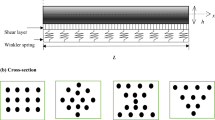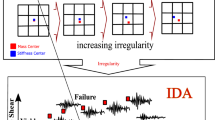Abstract
Physical modelling of cantilever retaining walls with and without backfill reinforcement was conducted on a 1g shaking table to evaluate the mitigation effect of reinforcement on system dynamics (g denotes the acceleration of gravity). The model wall has a height of 1.5 m with a scale ratio of 1/4 and retains dry sand throughout. The input motions are amplified to three levels of input peak base acceleration, 0.11g, 0.24g, and 0.39g, corresponding to minor, moderate, and major earthquakes, respectively. Investigation of the seismic response of the retaining walls focuses on acceleration and lateral displacement of the wall and backfill, dynamic earth pressures, and tensile load in the reinforcements (modeled by phosphor-bronze strips welded into a mesh). The inclusion of reinforcement has been observed to improve the integrity of the wall-soil system, mitigate vibration-related damage, and reduce the fundamental frequency of a reinforced system. Propagation of acceleration from the base to the upper portion is accompanied by time delay and nonlinear amplification. A reinforced system with a lower acceleration amplification factor than the unreinforced one indicates that reinforcement can reduce the amplification effect of input motion. Under minor and moderate earthquake loadings, reinforcement allows the inertia force and seismic earth pressure to be asynchronous and decreases the seismic earth pressure when inertia forces peak. During major earthquake loading, the wall is displaced horizontally less than the backfill, with soil pushing the wall substantially; the effect of backfill reinforcement has not been fully mobilized. The dynamic earth pressure is large at the top and diminishes toward the bottom.
摘要
目的
1. 探讨墙后填土加筋与否对悬臂式挡墙地震响应的影响规律;2. 评估填土加筋措施对改善悬臂式挡墙抗震性能的适用性。
创新点
1. 设计并制作填土加筋与填土未加筋的悬臂式挡墙模型,开展振动台模型试验的对比研究,并分析填土加筋对悬臂式挡墙地震响应的改善效果;2. 分析不同加载幅值作用下,墙-土相互作用的同步特性。
方法
1. 开展填土加筋与填土未加筋悬臂式挡墙的振动台模型试验;在模型底部分别输入加速度幅值为0.11g、0.24g及0.39g的正弦波,测试模型的加速度、位移、土压力及筋带拉力等响应量。2. 重点分析不同加速度幅值下模型的自振频率及阻尼比、加速度沿高度的放大规律、振动位移以及墙-土相互作用等规律,并对比模型动力特性及响应差异,明确悬臂式挡墙填土加筋的减震效应。
结论
1. 填土加筋对悬臂式挡墙的地震响应具有改善作用;加筋模型的加速度、位移、动土压力等响应量较未加筋模型更小。2. 基于均方根加速度的放大系数沿高度表现出显著的非线性放大效应,并随加载加速度幅值的增加呈加速增大特征。3. 悬臂式挡墙填土加筋可导致墙体所承受地震惯性力与地震土压力存在相位差,大幅降低最不利位移状态时墙体所受地震土压力;试验表明,未加筋模型中墙体惯性力与地震土压力基本同步,而填土加筋后,0.11g及0.24g加载工况下墙-土相互作用的同步性明显降低。
Similar content being viewed by others
References
Al Atik L, Sitar N, 2010. Seismic earth pressures on cantilever retaining structures. Journal of Geotechnical and Geoenvironmental Engineering, 136(10): 1324–1333. https://doi.org/10.1061/(ASCE)GT.1943-5606.0000351
Bathurst RJ, Hatami K, 1998. Seismic response analysis of a geosynthetic-reinforced soil retaining wall. Geosynthetics International, 5(1–2):127–166. https://doi.org/10.1680/gein.5.0117
Brennan AJ, Madabhushi SPG, 2009. Amplification of seismic accelerations at slope crests. Canadian Geotechnical Journal, 46(5):585–594. https://doi.org/10.1139/T09-006
Brennan AJ, Thusyanthan NI, Madabhushi SP, 2005. Evaluation of shear modulus and damping in dynamic centrifuge tests. Journal of Geotechnical and Geoenvironmental Engineering, 131(12):1488–1497. https://doi.org/10.1061/(ASCE)1090-0241(2005)131:12(1488)
Conti R, Madabhushi GSP, Viggiani GMB, 2012. On the behaviour of flexible retaining walls under seismic actions. Géotechnique, 62(12):1081–1094. https://doi.org/10.1680/geot.11.P.029
Ding GY, Zhou L, Wang J, et al., 2020. Shaking table tests on gravel slopes reinforced by concrete canvas. Geotextiles and Geomembranes, 48(4):539–545. https://doi.org/10.1016/j.geotexmem.2020.02.012
Edinçliler A, Toksoy YS, 2017. Physical model study of the seismic performance of highway embankments with and without geotextile. Journal of Earthquake and Tsunami, 11(2):1750003. https://doi.org/10.1142/S1793431117500038
Eftekhari Z, Panah AK, 2021. 1-g shaking table investigation on seismic performance of polymeric-strip reinforced-soil retaining walls built on rock slopes with limited reinforced zone. Soil Dynamics and Earthquake Engineering, 147: 106758. https://doi.org/10.1016/j.soildyn.2021.106758
El-Emam MM, Bathurst RJ, 2005. Facing contribution to seismic response of reduced-scale reinforced soil walls. Geosynthetics International, 12(5):215–238. https://doi.org/10.1680/gein.2005.12.5.215
El-Emam MM, Bathurst RJ, 2007. Influence of reinforcement parameters on the seismic response of reduced-scale reinforced soil retaining walls. Geotextiles and Geomembranes, 25(1):33–49. https://doi.org/10.1016/j.geotexmem.2006.09.001
Ertugrul OL, Trandafir AC, 2013. Lateral earth pressures on flexible cantilever retaining walls with deformable geofoam inclusions. Engineering Geology, 158:23–33. https://doi.org/10.1016/j.enggeo.2013.03.001
Ertugrul OL, Trandafir AC, Ozkan MY, 2017. Reduction of dynamic earth loads on flexible cantilever retaining walls by deformable geofoam panels. Soil Dynamics and Earthquake Engineering, 92:462–471. https://doi.org/10.1016/j.soildyn.2016.10.011
Gao HM, Hu Y, Wang ZH, et al., 2017. Shaking table tests on the seismic performance of a flexible wall retaining EPS composite soil. Bulletin of Earthquake Engineering, 15(12): 5481–5510. https://doi.org/10.1007/s10518-017-0189-4
Green RA, Olgun CG, Cameron WI, 2008. Response and modeling of cantilever retaining walls subjected to seismic motions. Computer-Aided Civil and Infrastructure Engineering, 23(4):309–322. https://doi.org/10.1111/j.1467-8667.2007.00538.x
Hardin BO, Drnevich VP, 1972. Shear modulus and damping in soils: design equations and curves. Journal of the Soil Mechanics and Foundations Division, 98(7):667–692. https://doi.org/10.1061/JSFEAQ.0001760
Hatami K, Bathurst RJ, 2000. Effect of structural design on fundamental frequency of reinforced-soil retaining walls. Soil Dynamics and Earthquake Engineering, 19(3): 137–157. https://doi.org/10.1016/S0267-7261(00)00010-5
Huang CC, 2019. Seismic responses of vertical-faced wraparound reinforced soil walls. Geosynthetics International, 26(2):146–163. https://doi.org/10.1680/jgein.18.00044
Iai S, 1989. Similitude for shaking table tests on soil-structure-fluid model in 1g gravitational field. Soils and Foundations, 29(1):105–118. https://doi.org/10.3208/sandf1972.29.105
Jo SB, Ha JG, Lee JS, et al., 2017. Evaluation of the seismic earth pressure for inverted T-shape stiff retaining wall in cohesionless soils via dynamic centrifuge. Soil Dynamics and Earthquake Engineering, 92:345–357. https://doi.org/10.1016/j.soildyn.2016.10.009
Kamiloğlu HA, Şadoğlu E, 2019. A method for active seismic earth thrusts of granular backfill acting on cantilever retaining walls. Soils and Foundations, 59(2):419–432. https://doi.org/10.1016/j.sandf.2018.12.003
Kilic IE, Cengiz C, Edincliler A, et al., 2021. Seismic behavior of geosynthetic-reinforced retaining walls backfilled with cohesive soil. Geotextiles and Geomembranes, 49(5):1256–1269. https://doi.org/10.1016/j.geotexmem.2021.04.004
Kokusho T, 1980. Cyclic triaxial test of dynamic soil properties for wide strain range. Soils and Foundations, 20(2): 45–60. https://doi.org/10.3208/sandf1972.20.2_45
Koseki J, Tatsuoka F, Munaf Y, et al., 1998a. A modified procedure to evaluate active earth pressure at high seismic loads. Soils and Foundations, 38(S1):209–216. https://doi.org/10.3208/sandf.38.Special_209
Koseki J, Munaf Y, Tatsuoka F, et al., 1998b. Shaking and tilt table tests of geosynthetic-reinforced soil and conventional-type retaining walls. Geosynthetics International, 5(1–2): 73–96. https://doi.org/10.1680/gein.5.0115
Kramer SL, 1996. Geotechnical Earthquake Engineering. Pearson, Upper Saddle River, USA, p.65–83.
Krishna AM, Latha GM, 2007. Seismic response of wrap-faced reinforced soil-retaining wall models using shaking table tests. Geosynthetics International, 14(6):355–364. https://doi.org/10.1680/gein.2007.14.6.355
Krishna AM, Latha GM, 2009. Seismic behaviour of rigid-faced reinforced soil retaining wall models: reinforcement effect. Geosynthetics International, 16(5):364–373. https://doi.org/10.1680/gein.2009.16.5.364
Krishna AM, Bhattacharjee A, 2017. Behavior of rigid-faced reinforced soil-retaining walls subjected to different earthquake ground motions. International Journal of Geomechanics, 17(1):06016007. https://doi.org/10.1061/(asce)gm.1943-5622.0000668
Li SH, Cai XG, Jing LP, et al., 2021. Lateral displacement control of modular-block reinforced soil retaining walls under horizontal seismic loading. Soil Dynamics and Earthquake Engineering, 141:106485. https://doi.org/10.1016/j.soildyn.2020.106485
Liu H, Han J, Parsons RL, 2021. Mitigation of seasonal temperature change-induced problems with integral bridge abutments using EPS foam and geogrid. Geotextiles and Geomembranes, 49(5):1380–1392. https://doi.org/10.1016/j.geotexmem.2021.05.010
Lu XL, Chen C, Jiang HJ, et al., 2018. Shaking table tests and numerical analyses of an RC coupled wall structure with replaceable coupling beams. Earthquake Engineering & Structural Dynamics, 47(9):1882–1904. https://doi.org/10.1002/eqe.3046
Mononobe N, Matsuo H, 1929. On the determination of earth pressure during earthquakes. Proceedings of the World Engineering Conference, p.177–185.
Nakajima S, Ozaki T, Sanagawa T, 2021. 1g shaking table model tests on seismic active earth pressure acting on retaining wall with cohesive backfill soil. Soils and Foundations, 61(5):1251–1272. https://doi.org/10.1016/j.sandf.2021.06.014
Osouli A, Zamiran S, 2017. The effect of backfill cohesion on seismic response of cantilever retaining walls using fully dynamic analysis. Computers and Geotechnics, 89:143–152. https://doi.org/10.1016/j.compgeo.2017.04.007
Ren FF, Huang QQ, Wang G, 2020. Shaking table tests on reinforced soil retaining walls subjected to the combined effects of rainfall and earthquakes. Engineering Geology, 267:105475. https://doi.org/10.1016/j.enggeo.2020.105475
Safaee AM, Mahboubi A, Noorzad A, 2021. Experimental investigation on the performance of multi-tiered geogrid mechanically stabilized earth (MSE) walls with wraparound facing subjected to earthquake loading. Geotextiles and Geomembranes, 49(1):130–145. https://doi.org/10.1016/j.geotexmem.2020.08.008
Samee AA, Yazdandoust M, Ghalandarzadeh A, 2022. Effect of reinforcement arrangement on dynamic behaviour of back-to-back mechanically stabilised earth walls. International Journal of Physical Modelling in Geotechnics, 22(4):208–223. https://doi.org/10.1680/jphmg.20.00088
Seed HB, Whitman RV, 1970. Design of earth retaining structures for dynamic loads. Proceedings of the ASCE Specialty Conference on Lateral Stresses in the Ground and Design of Earth Retaining Structures, p.103–147.
Tatsuoka F, Tateyama M, Koseki J, 1996. Performance of soil retaining walls for railway embankments. Soils and Foundations, 36(S1):311–324. https://doi.org/10.3208/sandf.36.Special_311
Tatsuoka F, Tateyama M, Mohri Y, et al., 2007. Remedial treatment of soil structures using geosynthetic-reinforcing technology. Geotextiles and Geomembranes, 25(4–5):204–220. https://doi.org/10.1016/j.geotexmem.2007.02.002
Tatsuoka F, Hirakawa D, Nojiri M, et al., 2009. A new type of integral bridge comprising geosynthetic-reinforced soil walls. Geosynthetics International, 16(4):301–326. https://doi.org/10.1680/gein.2009.16.4.301
Varnier JB, Hatami K, 2011. Seismic response of reinforced soil retaining walls: is PGA-based design adequate? Georisk 2011, p.336–343. https://doi.org/10.1061/41183(418)28
Veletsos AS, Younan AH, 1997. Dynamic response of cantilever retaining walls. Journal of Geotechnical and Geoenvironmental Engineering, 123(2):161–172. https://doi.org/10.1061/(ASCE)1090-0241(1997)123:2(161)
Wang LY, Chen GX, Chen S, 2015. Experimental study on seismic response of geogrid reinforced rigid retaining walls with saturated backfill sand. Geotextiles and Geomembranes, 43(1):35–45. https://doi.org/10.1016/j.geotexmem.2014.11.006
Watanabe K, Munaf Y, Koseki J, et al., 2003. Behaviors of several types of model retaining walls subjected to irregular excitation. Soils and Foundations, 43(5):13–27. https://doi.org/10.3208/sandf.43.5_13
Watanabe K, Nakajima S, Fujii K, et al., 2020. Development of geosynthetic-reinforced soil embankment resistant to severe earthquakes and prolonged overflows due to tsunamis. Soils and Foundations, 60(6):1371–1386. https://doi.org/10.1016/j.sandf.2020.08.006
Wilson P, Elgamal A, 2015. Shake table lateral earth pressure testing with dense c-ϕ backfill. Soil Dynamics and Earthquake Engineering, 71:13–26. https://doi.org/10.1016/j.soildyn.2014.12.009
Wood DM, 2004. Geotechnical Modelling. CRC Press, London, UK, p.233–258.
Wood DM, Crewe A, Taylor C, 2002. Shaking table testing of geotechnical models. International Journal of Physical Modelling in Geotechnics, 2(1):1–13. https://doi.org/10.1680/ijpmg.2002.020101
Xu C, Luo MM, Shen PP, et al., 2020. Seismic performance of a whole geosynthetic reinforced soil-integrated bridge system (GRS-IBS) in shaking table test. Geotextiles and Geomembranes, 48(3):315–330. https://doi.org/10.1016/j.geotexmem.2019.12.004
Xu P, Hatami K, Jiang GL, 2020. Study on seismic stability and performance of reinforced soil walls using shaking table tests. Geotextiles and Geomembranes, 48(1):82–97. https://doi.org/10.1016/j.geotexmem.2019.103507
Xu P, Hatami K, Jiang GL, 2021. Shaking table performance of reinforced soil retaining walls with different facing configurations. Geotextiles and Geomembranes, 49(3):516–527. https://doi.org/10.1016/j.geotexmem.2020.10.003
Yao JJ, Di DT, Jiang GL, et al., 2014. Real-time acceleration harmonics estimation for an electro-hydraulic servo shaking table using Kalman filter with a linear model. IEEE Transactions on Control Systems Technology, 22(2):794–800. https://doi.org/10.1109/tcst.2013.2256136
Yazdandoust M, 2017. Investigation on the seismic performance of steel-strip reinforced-soil retaining walls using shaking table test. Soil Dynamics and Earthquake Engineering, 97:216–232. https://doi.org/10.1016/j.soildyn.2017.03.011
Yu PJ, Richart Jr FE, 1984. Stress ratio effects on shear modulus of dry sands. Journal of Geotechnical Engineering, 110(3):331–345. https://doi.org/10.1061/(ASCE)0733-9410(1984)110:3(331)
Yünkül K, Gürbüz A, 2022. Shaking table study on seismic behavior of MSE wall with inclined backfill soils reinforced by polymeric geostrips. Geotextiles and Geomembranes, 50(1):116–136. https://doi.org/10.1016/j.geotexmem.2021.09.005
Zheng Y, McCartney JS, Shing PB, et al., 2018. Transverse shaking table test of a half-scale geosynthetic reinforced soil bridge abutment. Geosynthetics International, 25(6): 582–598. https://doi.org/10.1680/jgein.18.00019
Acknowledgments
This work is supported by the National Natural Science Foundation of China (Nos. 41901073 and 52078435) and the Sichuan Science and Technology Program of China (No. 2021YJ0001).
Author information
Authors and Affiliations
Contributions
Qiang LUO designed the research. Ming WEI and Guishuai FENG processed the corresponding data. Ming WEI wrote the first draft of the manuscript. Liang-wei JIANG helped to organize the manuscript. Teng-fei WANG revised and edited the final version.
Corresponding author
Additional information
Conflict of interest
Ming WEI, Qiang LUO, Gui-shuai FENG, Teng-fei WANG, and Liang-wei JIANG declare that they have no conflict of interest.
Rights and permissions
About this article
Cite this article
Wei, M., Luo, Q., Feng, Gs. et al. Shaking table tests on a cantilever retaining wall with reinforced and unreinforced backfill. J. Zhejiang Univ. Sci. A 23, 900–916 (2022). https://doi.org/10.1631/jzus.A2200192
Received:
Accepted:
Published:
Issue Date:
DOI: https://doi.org/10.1631/jzus.A2200192
Key words
- Cantilever retaining wall
- Backfill reinforcement
- Seismic response
- Shaking table test
- Dynamic earth pressure
- Phase shift




